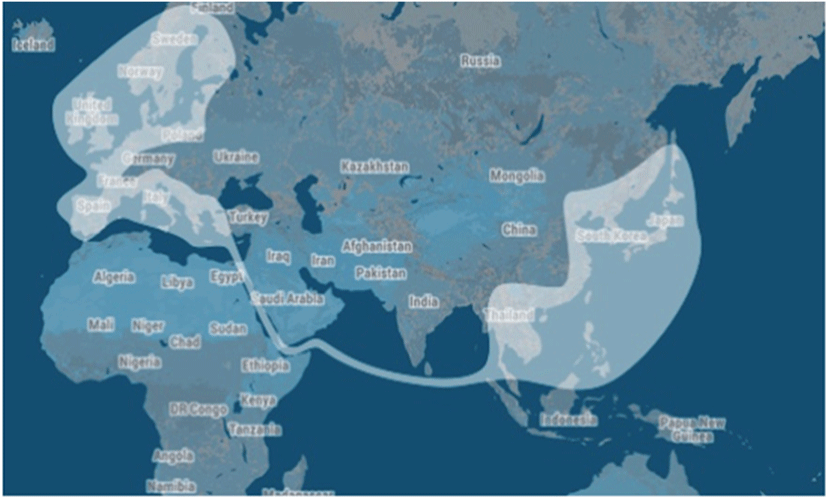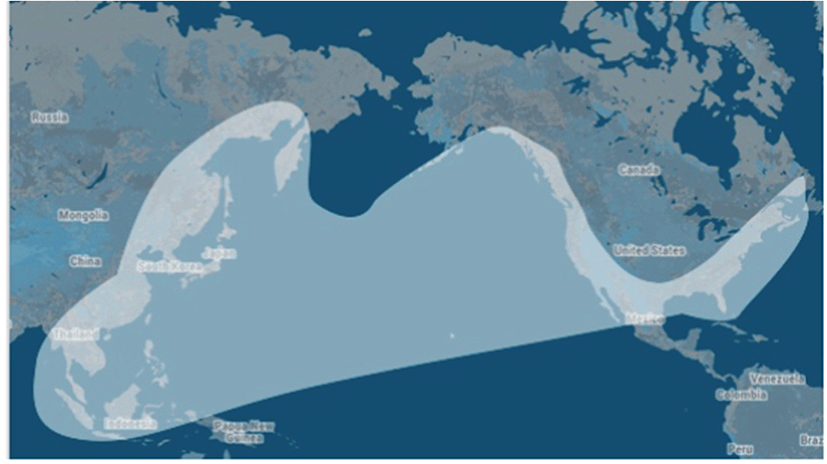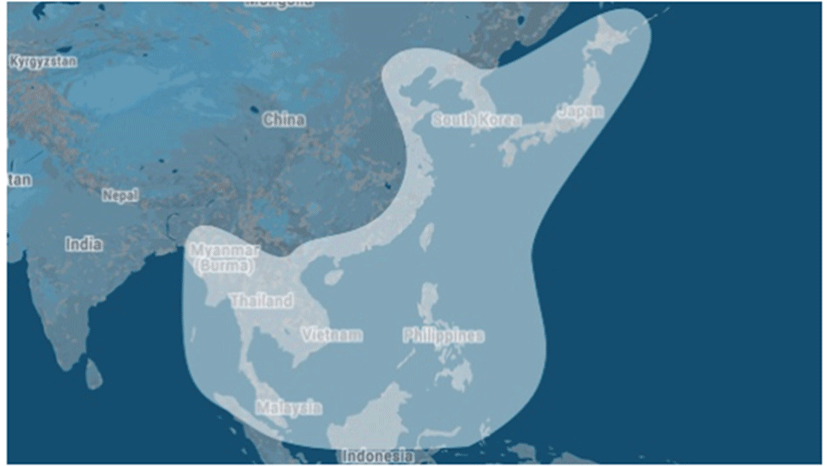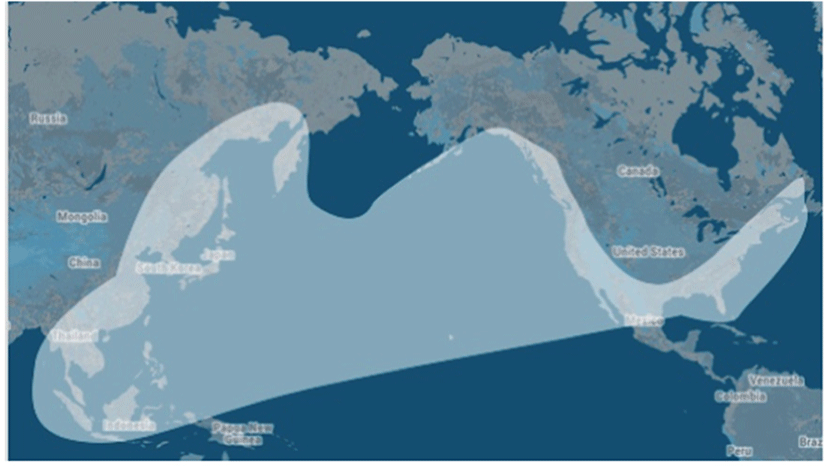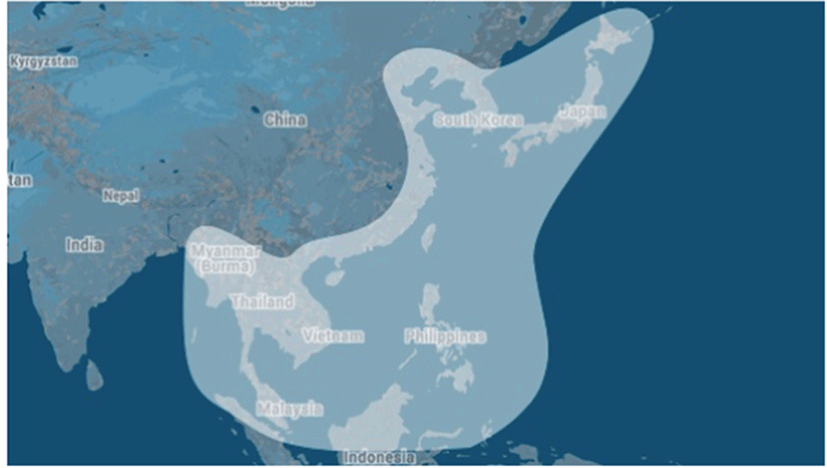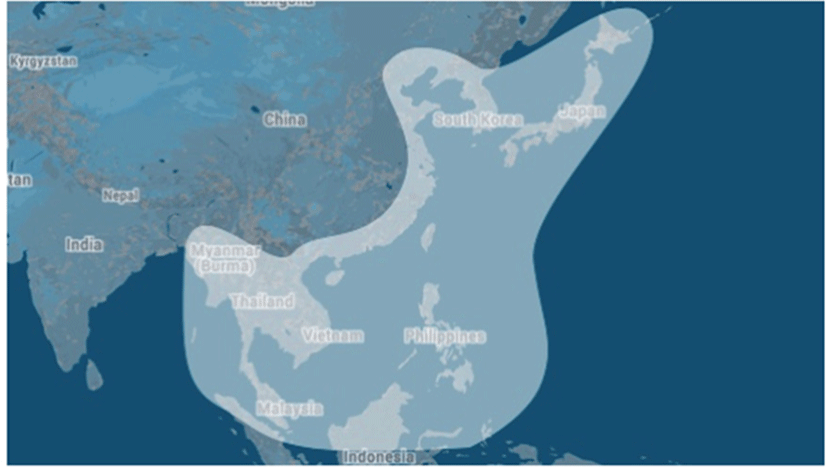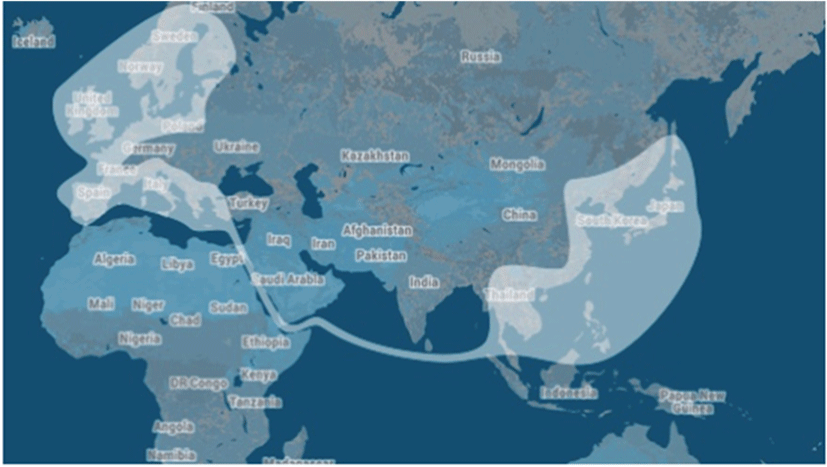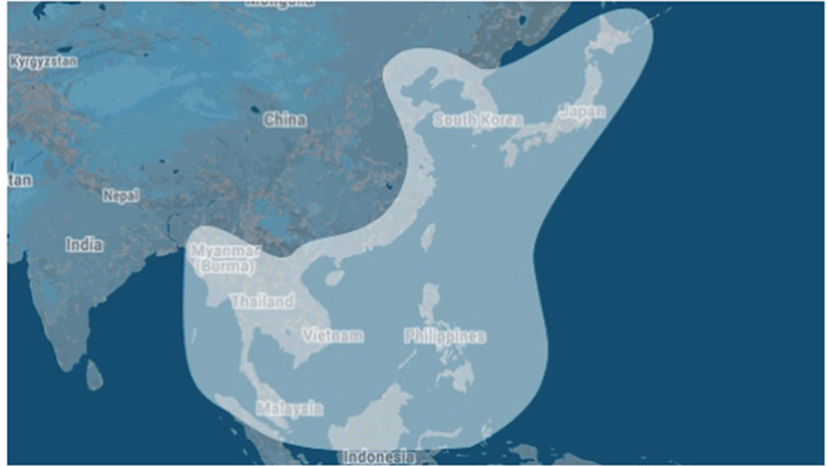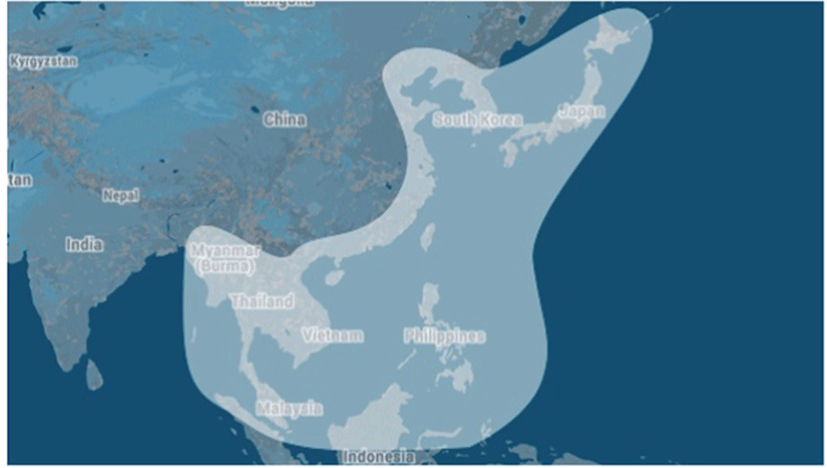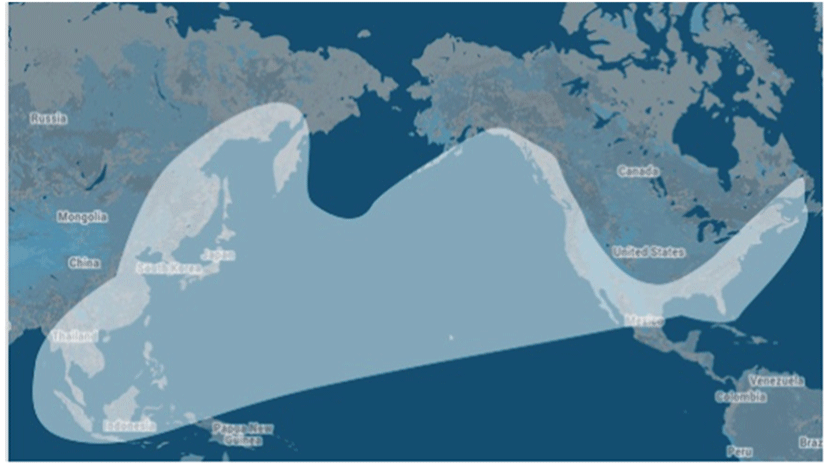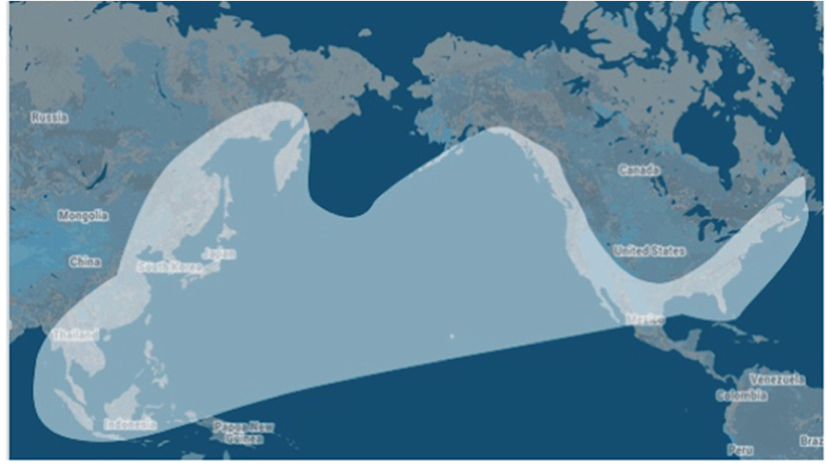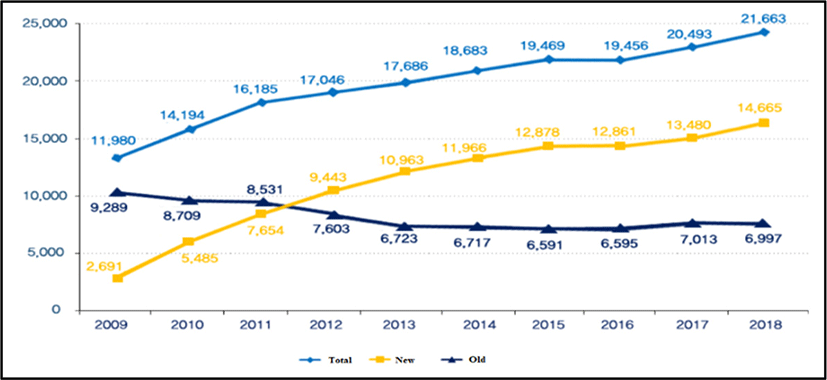1. Introduction
Seaports serve as a gateway to international trade, integrating a region into the world, which is crucial for the region’s economic growth (Chang et al., 2014; Del Mar Cerban et al., 2011; Goss, 1990; Haynes et al., 1997; Shan et al., 2014). As ocean transportation comprises 80% of the international trade of commodities, the seaports (hereafter referred to as ports) hold two primary responsibilities: (i) connecting the seaborne transportation to hinterland connectivity and (ii) improving the regional economy (Jung, 2011; Park and Seo, 2016). Port facilitates exports and imports of raw materials and containerised products, indirectly enhancing the regional economy. It also provides value-added services and employment in the region, directly boosting the local economy. Hence ports need to be strategically built and operated to support the country’s economy.
The growth of globalisation has led to a shift in production centres. Asia has become the manufacturing hub, serving the needs of the world. Hence we observe significant growth of container ports in the Asian region. Nine out of the top ten container ports in terms of annual container throughput are from the Asian region (Llyod’s List, 2021). However, most of these large ports are located in China. Seven out of the top ten container ports are from China, while only Singapore and Korea’s Busan port are the only two ports from other Asian countries in the top ten global container ports. The surge in the throughputs of Chinese ports creates intensive competition for the neighbouring ports.
Asia is the container trading hub of the world, with almost half of the world’s container ships deployed to provide liner services connecting the region to the world. The port and maritime trade related data were not readily available in the past. So, several strategic decisions for ports were not entirely scientific and somewhat depended on qualitative information. Due to the development of digitalisation and availability of maritime and ports related data, this study aims to investigate the trade patterns for top ports in three major Asia economies – China’s Shanghai port, Singapore port and Korea’s Busan port. Secondly, this study aims to operationalise the conceptual framework of Song (2003) on port co-opetition with empirical data to observe the competitive and co-operative strategies between the mentioned three major Asian ports. Finally, as there exists intense competition between Chinese and non-Chinese ports in the Asian region, this study observes the challenges and opportunities for Busan port as a strategic direction for non-Chinese port perspective in the region.
The remaining section of the study is presented as follows: Section 2 provides an overview of container trade in Asia. The method and dataset used for the analysis are presented in section 3. Section 4 presents findings of competition and co-operation for major Asian ports. The challenges and opportunities for Port of Busan are presented in section 5. This section also provides some qualitative recommendations from the findings to improve the market share for Busan port. Finally, section 6 provides the concluding remark of the study.
2. Trade Patterns in Asia
Asia is the industrial centre of the world where over 50% of the world export and import of goods and commodities by value take place from or to Asian countries. In 2019, Asia’s total export and import of $7.24T and $7.69T, respectively (Source: Exportgenuis), while the world export and import were around $18.00T (Source: OEC World). Amongst Asian countries, that serves as the major exporting nation. During the last three decards, the exports of China have increased by $2.56T from $84.94B in 1992 to $2.65T in 2020. The most recent exports are led by broadcasting equipment, computers, semiconductors, and machinery. China mainly exports to the United States, Japan, Germany, and Korea. As China is a substantial industrial country, it imports raw materials and equipment such as crude oil, iron ore, soybeans, automobile equipment, and integrated circuits from Japan, Korea, the United States and Germany.
Since this study aims to compare competitive and co-operative strategies between three major Asian ports: Shanghai, Singapore, and Busan port, this section concentrates on the economic and trade activities of the corresponding countries as a basis for port operations (Park and Medda, 2018). Unlike China, Singapore is a smaller country with a GDP of only $340B as of 2020; however, the strategic location could be regarded as one of the main factors for Singapore to be a key player in international trade. In 2020, Singapore had an export and import of $281B and $301B, respectively, which sums to be greater than the country’s economy. It primarily trades with crude oil, refined petroleum products, precious metals, medicinal products, electronics and machinery with China, the United States, Malaysia, Indonesia and Japan.
The economy of Korea is different as compared to that of China and Singapore. The per capita GDP of Korea is three times that of China. Hence labour cost in Korea is greater than that of China. Further, unlike Singapore, Korea does not have a very high value of trade vis-à-vis its large economy. In 2020, Korea exported a total of $531B compared to $446B of imports. However, the country’s trade surplus has decreased from $116B in 2015 to only $95B in the year 2020. Korea primarily exports electronics, automobiles, and cargo and passenger ships while importing crude oil and energy products. This could be mainly due to the development of electronic companies such as Samsung and automobile and heavy industries such as Hyundai. The details of the top 10 exporting and importing countries for China, Singapore, and Korea is presented in Table 1.
Source: OEC World (2022), https://oec.world/
As the maritime industry enables over 80% of the world trade demand, the ports play a crucial role in facilitating the export and import of goods and commodities in Asia, boosting the regional economies. The throughput data of the top 10 container ports in the world are presented in Table 2. It is interesting to observe that 9 out of the top 10 container ports are solely located in three Asia countries: China, Singapore, and Korea. It can also be seen in Figure 1 that the throughput of Asian ports has increased significantly over two decades. For example, the Port of Ningbo and Guangzhou had only a throughput of 1.2 and 1.6 million TEUs respectively in 2001, which ascended to over 31 and 24 million TEUs volume by 2021. At the same time, there are other Asian ports, such as Hong Kong, that did not grow by cargo handling volumes. This might be a result of an internal decision of the Government of China; however, other neighbouring countries with large ports, such as Singapore and Korea, need to develop strategies for remaining competitive and attracting volumes to their ports.
Source: Clarksons Research (2022).
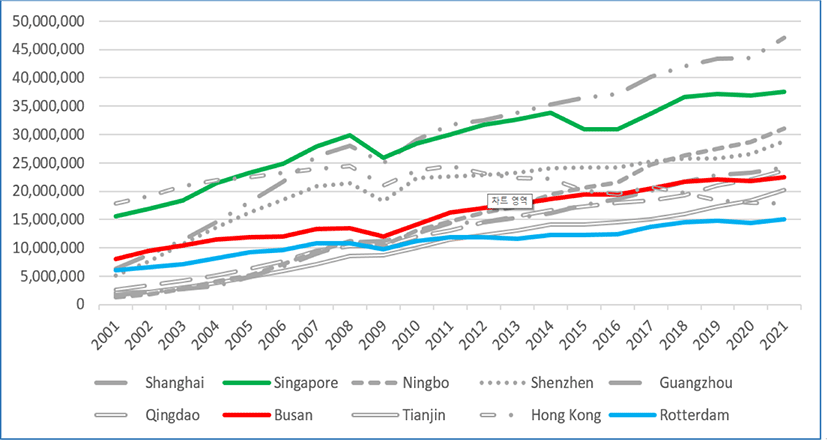
3. Competition and Co-operation from An Asian Ports Perspective
The competition and co-operation within regional ports are well investigated in the literature (Luo et al., 2022). Ports compete with other regional ports at different levels to increase their market share (Slack, 1985) and satisfy the growing demand (Verhoeff, 1981). Inter- and intra-port competition between port operations for acquiring hinterland shipment and transhipment as a non-cooperative strategy is investigated in Song et al. (2016). On the other side, ports handling similar or even different types of cargo can develop co-operative strategies to serve their customer better and improve management. A practice of port co-operation, integrating vertical and horizontal chains of transportation in Asian and European contexts, is presented in Ryoo (2011) and Stamatović et al. (2018).
Song (2002) examines the competition and co-operation existed between the container ports in Hong Kong and South China from a strategic point of view. In the early 1990s, Hong Kong was the largest container port in the world, but after 1997, when its sovereignty was handed to China, it faced steep competition from neighbouring Chinese ports, notably Shenzhen and Guangzhou. The impact of such competitive strategies is now observed with the continuous decline of the container throughput for Hong Kong and the growth of the adjacent ports in South China. Using a game theory approach Wang et al. (2012) identifies several factors such as regional port governance for supporting co-operation and alliance formation to attract container volumes from contestable hinterlands. It also helps to develop an efficient logistics hub with a fully integrated transport ecosystem. Anderson et al. (2008) also extended the study of port competition from a game-theoretical perspective to understand how competitor ports respond when a neighbourhood port grows faster to become the regional container hub port. It also presents whether and how the growing port captures and defends market share by building additional infrastructure. The study also investigates the game theory framework using a case study between Busan and Shanghai ports. Hence, port co-operation and integration, in general, are also advantageous transportation from a business and social perspective (Álvarez-SanJaime et al., 2015).
Though the concept of competition and co-operation between ports is extensively investigated, there are only centres around quantifying the degree of competition and co-operation between ports. Asgari et al. (2013) is one of the few articles which empirically investigates the competition and co-operation between two major hub ports in Asia (Singapore and Hong Kong) using scenario analysis. Furthermore, studies limit competitive and co-operative strategies for ports only to hinterland market. This study aims to provide a simple empirical analysis to understand the port dependency on neighbouring ports in the region from the foreland perspective. But doing so, the study also helps to understand the trading pattern of container services for major ports in Asia using liner services data that can enhance the management decision making for ports, container lines, and even regional governments (Sena et al., 2019; Tan et al., 2017). The development of technology facilitates this aspect by digitising operations, storing colossal information, and processing useful findings almost instantaneously. The live and historical positions of ships are tracked through automated identification system (AIS), stored and processed through various cloud platforms. Technology has also become cheaper and more predominant over time. Hence, observing the trading pattern of container liner services to understand the dependency of ports on other ports in the region is possible.
Container shipping is a form of liner service with fixed routes and port calls at the scheduled time. Since the container line services do not receive all the loading and discharging container boxes from a single port in the region, they rely on several ports to attract large volumes. For example, for the liner services between Far-East and North-Europe route, the boxes are typically loaded in Asian ports and unloaded in European ports as most of the finished products carried in the boxes are manufactured in Asia due to low labour cost and well-established production ecosystem, and consumed in Europe as it has higher per capita GDP. If we observe the loading centre for this service route, not all the containers are loaded from China. There are other major manufacturing countries like Indonesia, Malaysia, Vietnam, Thailand, Bangladesh and India, amongst others, who either provide cargo volume to the Europe-Asia route directly or through transhipment ports such as Singapore and Busan.
Moreover, multiple mega ports within China produce their cargo volumes and attract liner services. From a liner service provider perspective, since it is not possible to get the entire volume of cargo from a single port, it is ineffective to call only one port in the region instead of a loop of ports that meets its container volume requirement. Hence regional/adjacent container ports need to co-operate with other ports to attract container liner services. Additionally, ports strategically develop value-added services complementing the adjacent ports and establish a logistics ecosystem. Similar co-operation strategies are also designed for the regional ports at the discharge area, for European ports in this example.
To understand the intra-dependency of the ports, it is essential as well to assess the trading pattern (export and import) of commodities for the corresponding countries. It is observed that Korea majorly trades with China, USA and Japan, as presented in Table 1 earlier in the text. It also has other Asian and European countries as strong trade partners. Similar to Korea, China and the USA are the leading trade partners for Singapore. Singapore also presents a good trade relationship with other Asian countries, mainly from the South Asian region. The volume of goods/commodities exported to and imported from China is significantly higher than that of Korea and Singapore. Unlike the two countries that have China as the major trade partner, the USA is the major trading country for China. China also has a strong trade relationship with the Far East countries (including Japan and Korea), South Asian countries such as Vietnam and Malaysia, and Europe. The differences in import and export of commodities create the balance of trade for any country and establish dependency on each other. This dependency of countries on each other for trade creates resilience to find another trading partner, which is reflected in their corresponding trading ports creating co-operation and intra-dependency between ports.
4. Method and Data Issue
Regional ports compete and co-operate to get a larger volume of cargo. Usually, this competition for cargo volume is for transhipment containers and not for hinterland containers since port generating their hinterland volumes have fewer options to share with other regional ports. Transhipment containers increase the throughput volatility of a port (Notteboom et al., 2019) due to the fact that a calling-port decision is made by shipping companies; hence things become risky for the ports. Ports with higher transhipment volumes compete with the adjacent ports in retaining and increasing their volume, which otherwise can significantly reduce their throughput volume, leaving them out of the mainline routes.
As shown in Figure 2, Tokyo had an annual throughput of 2.3 Million TEUs, and Busan had a yearly throughput of 4.7 Million TEUs in 1996. However, in 2021, Tokyo’s throughput only raised to 4.5 Million TEUs while Busan generated a volume of 22.5 Million TEUs. Thus, Tokyo was receiving around half of the volume of Busan, which has dropped to 1/4th in 25 years. Even though both the ports are located in the same region, by attracting large volumes of transhipment containers, the Port of Busan has emerged as the leading port in Far East Asia.
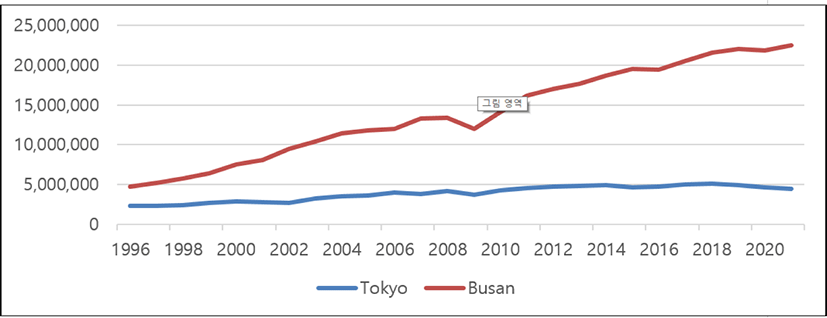
As regional ports co-operate for existence and compete to scale up their size, they need to develop a strategy to tradeoff between the competitive and co-operative for a win-win scenario between ports (Hales et al., 2016). Brandenburger and Nalebuff (1995) introduced the word co-opetition, referring to a game theory strategy where players co-operate and compete. This is also in line with the context of port co-opettiion concept proposed by Song (2003). Though port co-operation is essential, there are only limited studies empirically evaluating the degree of co-operation or dependency between ports. This study attempts to present the port intra-dependency ratio from the foreland perspective to quantify the dependence of a port with adjacent/reference ports as follows:
Where, represents the port intra-dependency ratio of port i on the adjacent/reference port(s) j which are using the common liner services. Twenty-foot equivalent unit (TEU) indicates the average weekly 20-foot equivalent container capacity calling at the port.1 The ratio () estimates the percentage of the volume of cargo (in the form of TEU) which a port i depends on the reference port(s) j compared to its total volume. A higher (lower) denotes higher (lower) dependency of port i on reference port(s) j. This port intra-dependency ratio is an augmented form of port dependency ratio presented in DeSalvo (1994) and Won et al. (2006) which is derived from the demography and health economics literature (Loichinger et al., 2017; Muszyńska and Rau, 2012; Sinnathurai, 2013).
AXSMarine’s Alphaliner database is used to collect the data related to the container liner services and the vessels allocated for each service. Alphaliner combines individual vessels allocated for each container liner service with the ship’s AIS to provide updated routes and port calls.2
Currently, there are 1,842 container liner services provided around the world through 6,136 container ships. There are 3,016 container vessels which are responsible for delivering 767 liner services connecting Asia to the world. The Port of Shanghai is connected with 374 container liner services with the help of 1,761 container ships, making it the largest liner network globally. Singapore and Busan port have the most extensive network outside of China, with 334 and 261 weekly liner services, respectively. Container ships of a cumulative capacity of over 1.5 million TEUs call Shanghai every week, whereas Singapore and Busan receive 1.34 million and 925 thousand TEU capacity weekly. Table 3 provides the details of the number of services, vessels allocated, and weekly TEU capacity for the ports.
| World container trade | Busan | Singapore | Shanghai | ||
|---|---|---|---|---|---|

|
No. of services | 1,842 | 261 | 334 | 374 |

|
No. of vessels deployed | 6,136 | 944 | 1,247 | 1,761 |

|
Avg. TEUs capacity per week | 3,600,134 | 925,332 | 1,340,815 | 1,525,531 |
Source: AXS Marine (2022).
5. Competition and Co-operation among Major Asian Ports
The container liner services are operated in a close loop, where the liner services call multiple loading and unloading ports. A total of 261 container liner services with a cumulative capacity of 925,332 TEUs call Busan port every week, whereas Singapore and Shanghai receive a cumulative capacity of 1,340,815 and 1,525,531 TEU from 334 and 374 container liner services weekly. There exists 54 common container services between Busan, Singapore, and Shanghai port which provides a total of 457,859 TEU capacity weekly. There are eight liner services common between Busan and Shanghai exclusively3, while Shanghai shares a high number of common liner services (83 and 64 respectively) with both Busan and Singapore. Hence, Busan and Singapore have less dependency in terms of liner shipping volumes, while both the ports have a greater dependence on Shanghai for getting their volumes. There are only 116 liner services exclusively calling Busan (that is, not calling Singapore and Shanghai), generating a cumulative container capacity of 104,957 TEUs per week. This is lower than 1/9th of the weekly TEU capacity, indicating that, Busan heavily relies on Singapore and Shanghai for getting its cargo volume. On the other side, Singapore gets around 531,189 TEU capacity weekly from 208 liner services which do not call Busan and Shanghai, indicating that Singapore port can generate a higher cargo volume without depending on Singhai and Busan ports. Shanghai receives about 1/4th (402,355 out of 1,525,531) of its TEU capacity on its own. Shanghai has a large hinterland for which it can self generate higher cargo capacity without depending on the other two ports. In contrast, despite being a transhipment port, Singapore generates a higher TEU capacity without relying on adjacent ports (Busan and Shanghai), indicating a well-diversified liner services network. The container market share for Busan, Singapore, and Shanghai is presented using a diagram in Figure 3.
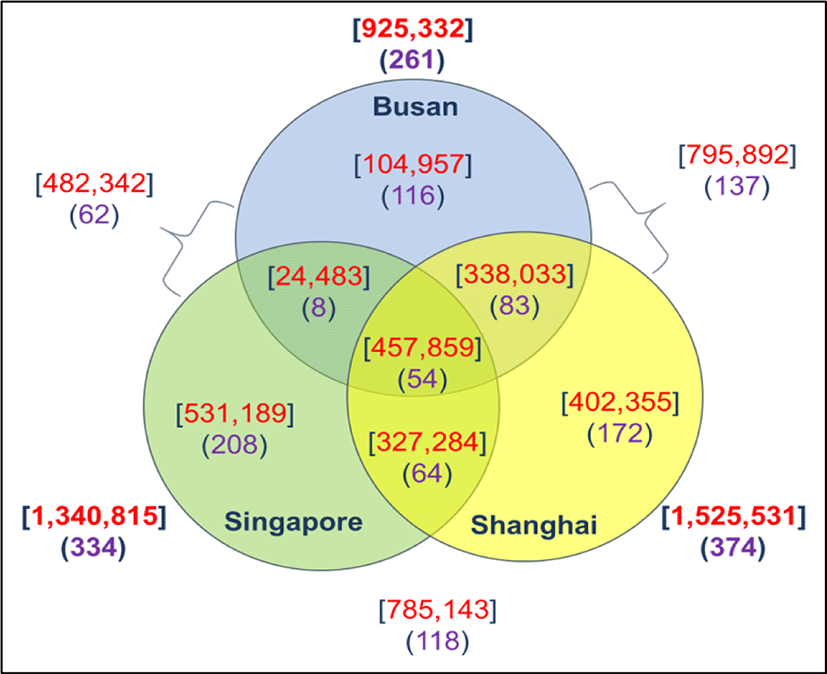
As observed in the Venn diagram, the entire container market share for Busan, Singapore, and Shanghai can be divided into three zones as follows:
-
The Common liner services indicate the liner services that call Busan, Singapore, and Shanghai.
-
Liner services for two ports only: This includes the liner services calling only two ports, that is, (i) Busan – Singapore, (ii) Busan – Shanghai, or (iii) Singapore – Shanghai.
-
Liner services only calling one port: Out of the three ports considered in the analysis, this includes the liner services calling only Busan, Singapore, or Shanghai.
Based on the three mentioned categories of liner services, the intra-port dependency ratio is evaluated and explained in the following section.
The port intra-dependency ratio () for Busan port with respect to adjacent all three ports (port i is Busan while ports j are Busan, Singapore, and Shanghai) is 49.48%, indicating that Busan depends on Singapore and Shanghai ports for almost 50% of its volume. Similarly, the port intra-dependency ratio () for Singapore and Shanghai ports are 34.15% and 30.01%, respectively, suggesting that Shanghai and Singapore still depend on other ports for generating their volumes, but to a lesser extent than Busan port.
North Europe – Mediterranean – the Far East is (Figure 4) the most popular common container liner route, which calls Singapore, Shanghai, and Busan. There are 20 container liner services in this route which calls the three ports generating an average cumulative capacity of 312,096 TEUs per week. North Europe – Mediterranean – the Far East is also the most container liner routes.
The second most popular liner trading route calling all three ports is the North America – Asia route (Figure 5), providing seven weekly container services with an average capacity of only 39,209 TEUs. Even though this route provides less cargo volume than the Europe – Asia route, this is an important trading route for Shanghai and Busan. The United States is the largest trading for China, with an export value of 453 Billion USD in 2020 (sources: UN Comtrade); and Busan is the largest port in the Far East region, making it the gateway between the two continents.
Only six container liner services call Busan and Singapore which do not call Shanghai (Figure 6), implying Busan and Singapore do not have an extensive dependency on each other. This is reflected in the lower port intra-dependency ratio of only 2.65% and 1.83% for Busan and Singapore on the trade between the two ports, respectively. Since both the ports are transhipment ports, they compete for the generating volume in the region, limiting the exclusive trade between the two ports. Furthermore, the liner services exclusively between Singapore and Busan are limited within the Asian region. Only four liner services operate solely between Busan and Shanghai, providing a container capacity of 13,988 TEUs weekly. There are also two liner services connecting the Far East to the Indian subcontinent calling Busan and Singapore. Overall, it is observed that no long trading routes connecting Singapore and Busan exclusively. All the longer liner services connecting Singapore and Busan have Shanghai as a port call.
Busan and Shanghai have a higher port dependency on each other, with a large number of common liner services between the two ports (Figure 7). The port intra-dependency ratio for Busan on Busan – Shanghai trade is 36.53%, while for Shanghai is 22.16%. This indicates that Busan depends on the common services between the two ports more than Shanghai. Two major liner service routes which call Busan and Shanghai (and not calling Singapore) include North America to Asia and Intra Asia to Oceania routes. There are 39 liner services between North America and Asia which exclusively calls Busan and Shanghai every week with a cumulative capacity of 259,793 TEUs.
Intra Asia to Ocean (Figure 8) is another major route calling the two ports, with 34 container services and an average of 58,951 TEU cumulative capacity every week. Small container vessels are allocated in this route, resulting in lower volume capacity. All the container routes between the Far East to Europe call Singapore; hence, there are no liner services on Europe – Asia route exclusively calling Busan and Shanghai.
Though Singapore is a transhipment port and Shanghai (Figure 9) receives its major cargo from the vast Chinese hinterland, the port intra-dependency between Singapore and Shanghai is comparable. The intra-dependency ratio for Singapore is 24.41%, while for Shanghai is 21.45%. This indicates that though Singapore has a high volume of transhipment containers, it has a well-diversified source of cargo volume and does not depend on only Chinese cargo. There are 20 liner services in North Europe – the Mediterranean – the Far East, providing port call services to Singapore and Shanghai that do not call Busan port with a cumulative 165,766 TEU capacity weekly. This indicates that there are a large number of Europe to Asia trade that Busan port are not attracting.
Additionally, there are also 20 Intra-Asia container liner services which connect North-East Asia to South East Asia through Singapore and Shanghai (Figure 10). It suggests that there are opportunities for Busan to identify and develop strategic partnerships with these liner services to generate higher cargo volume.
The port intra-dependency of Busan on itself is only 11.34% indicating that the Port of Busan depends extensively on cargo volume from Shanghai and Singapore (Figure 11). It also refers that Busan does not have a well-diversified liner route portfolio with a lower self-dependency ratio. Busan port has a low self-dependency ratio and is more serving for transhipment cargo, making it vulnerable since any risks, such as geopolitical, financial or even pandemic, that affect either Singapore or Shanghai will have a high impact on Busan’s throughput. There are also no major liner routes that call Busan exclusively. It has a good liner network within Asia, providing 104 services exclusively to Busan with an average capacity of only 82,337 TEU weekly. It also suggests that through Busan has a good network of services within Asia, the port still has to improve its connectivity beyond Asia to compete with the adjacent ports.
Though Singapore is also a transhipment port like Busan it is able to generate a high volume of cargo on its own as its self-dependency ratio is as high as 39.62%. It also indicates that Singapore relies on Shanghai and Busan for almost 60% of the TEU capacity (sharing common liner services), and it can generate about 40% of the volume capacity from its exclusive liner services that do have Shanghai or Busan has port calls. The high self-dependency might be attributed due to two reasons: (i) the strategic location of Singapore, which makes it the hub of transhipment for not only South Asia but also links between Africa and Oceania; and (ii) even though there are other ports in Malaysia, Indonesia and Philippines location in the same region of Malacca Strait, due to improved operational efficiency, value-added services offered and well established strategic partners, Singapore is able to attract container liner.
Singapore is the central transhipment hub for Africa – Oceania and Intra – Asia routes (Figure 12). There are 154 liner services in these routes providing a cumulative capacity of 321,194 TEUs per week. This provides a significant cargo volume to Singapore over the adjacent ports and helps in diversification and risk management.
There are also 16 liner services in the North America – Asia route (Figure 13), which exclusively calls Singapore (and does not call either Shanghai or Busan port) with a weekly TEU capacity of 64,864 units. Though it is a small trade volume, it is unique as it strategically connects South Asia and Africa to North America. Hence, Singapore stays futuristic, connecting the production and labour hub to consumer hub, and hedges itself for the US-China trade war, diversifying its risks.
Contrary to Singapore and Busan (Figure 14), Singapore is not a transhipment port, rather services as a major exporting port for China servicing its colossal hinterland. This also helps Shanghai to create its own cargo volume rather than depending on adjacent ports. The self-dependency ratio for Shanghai is relatively stable at 26.37%. There are 134 container liner services which call Shanghai (and do not call Busan and Singapore) in Intra Asia and Oceania route (including domestic routes). These services provide a cumulatively 191,905 TEUs on a weekly basis. There are also 14 exclusive liner services between North America and Asia with a 95,258 TEU capacity weekly.
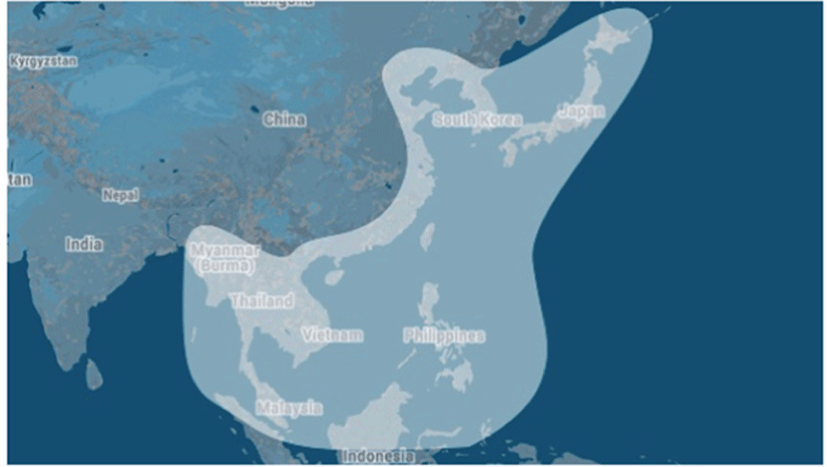
These exclusive North America liner services do not call Busan, even though it is located at the intersection of both continents. It also suggests a high volume of trade between North America and China (Figure 15) for which shipping lines can provide dedicated direct services.
Table 4 summarises the port intra-dependency ratio for all the scenarios explained earlier. The results suggest that, amongst the three ports, Singapore has the highest self-dependency ratio, followed by Shanghai, and Busan has the lowest self-dependency ratio. On the contrary, Busan has the highest port intra-dependency ratio on the common liners between Busan, Singapore, and Shanghai, indicating that Busan depends heavily on the co-operation between the three ports.
Comparing Busan and Singapore ports, as both serve higher transhipment volumes, it is observed that Busan has the highest dependency on Busan-Singapore-Shanghai liner services, followed by Busan-Shanghai liner services and then on itself. On the other hand, Singapore has the highest dependence on itself, followed by Busan-Singapore-Shanghai and Singapore-Shanghai liner services. This increased dependency on a few adjacent ports can increase the risks of Port of Busan, especially for the transhipment cargo volume. If Busan aims to become the transhipment hub in the Far East, it needs to reduce its dependency on Busan-Singapore-Shanghai services (say from 50% currently to less than 35% as that of Singapore) and needs to increase its self-dependency from about 11% currently to nearly 40% (similar to Singapore).
6. The Position of Busan Port within Asia: Challenges and Opportunities
After understanding the intra-dependency of three major ports in Asia, this section focuses on Busan port as a case study to present the recent development of the port and addresses several challenges and opportunities which could support port authority and policymakers to build a strategic partnership with other countries, organisations and liner companies. It will help Busan port in two ways: (i) to improve container throughput for increasing the port throughput, and (ii) to reduce the risks of transhipment volumes by diversifying the liner network connectivity for Budan port.
Busan port was started in 1876, with the container operations commencing in the 1980s. Since the 1990s, the Busan port has been one of the top 10 largest container ports globally. The construction of Busan New Port started in 1995, and until 2020, six out of ten planned terminals are operational. Figure 16 shows the satellite image of the old and new terminals at Busan port. The highlighted section on the right side of the image indicates the old terminals, while the left side presents the new container terminals.
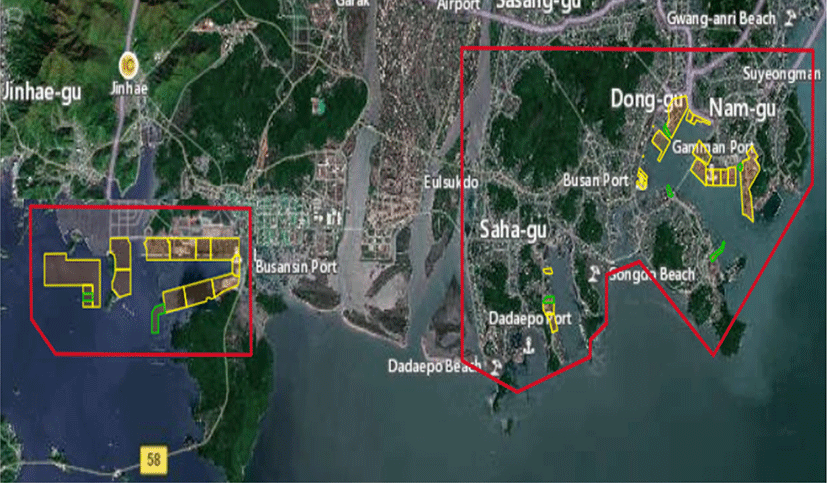
There are nine dedicated container terminals in the old Busan port; two midsize to Panamax container capacity, five terminals with Very Large Container Ships (VLCS) capacity, and two terminals capable of accommodating Ultra Large Container Ships (ULCS). The names of each terminal at the old Busan port are presented in Table 5. The old terminals do not have well-established railway connections. It can handle a total capacity of 6,677,000 TEU annually.
Source: AXS Marine (2022), Alphaliner (2022).
Unlike the old container terminals, the new terminals are modern, capable of accommodating ULCS and are all connected with rail networks. The six operating container terminals have a cumulative capacity of handling 13.7 million TEUs annually. Table 6 presents the capacity of each terminal.
Source: Alphaliner (2022).
The container throughput of the new port has significantly increased vis-à-vis the old port since 2011. Currently, almost 68% of the total throughput is handled by the new port (see Figure 17 for understanding the trend of the annual throughput for the two ports). In 2019, Busan port catered to almost 75% of the total throughput of the Republic of Korea.
Busan port handles about 95% of the entire transhipment volume of the Republic of Korea. The total annual capacity of Busan port is 20.377 million TEUs in 2021. In 2019, 11.636 million TEUs (52.9%) were transhipment volumes, 5.280 million TEUs (24.01%) were import volumes, and 5.074 million TEUs (23.07%) were export volumes. The total export and import volumes have been declining from 55.4% in 2010 to around 47.1% in 2019, and the transhipment volumes have been increasing from 44.3% in 2010 to 52.9% in 2019. This indicates that the Busan port is heading from a traditional export/import port to a transhipment port. The detailed container throughput statistics of Busan are presented in Table 7.
Source: Busan (2022).
Even though the Asian ports are increasing their throughput volumes, some ports are able to acquire a larger market share, whilst others are looking for their market share. Port of Busan faces fierce competition from the neighbouring Chinese ports. In 2001, Busan was the 3rd largest container port in the world, but it dropped down to the 7th position in 2021. As shown in Figure 18, within the Asian container trade market, the share of Shanghai port has increased from 2.95% in 1996 to 9.60% in 2021, while Busan port has reduced its market share from 7.23% in 1996 to only 4.59% in 2021. Port of Qingdao is marginally lower than Busan in 2019 with a high annual growth rate which surpasses Busan port in 2020. Seven out of the top 10 container ports are located in China which attracts large volumes of cargo and limits the growth of Busan port. Additionally, Busan port has a high dependency ratio on common liner services calling Singapore and Shanghai port (as explained earlier in section 4.8). Since over 50% of the throughputs for Busan are transhipments in nature, this high dependency ratio for Busan on neighbouring ports might be detrimental for the port in both the short and long term.
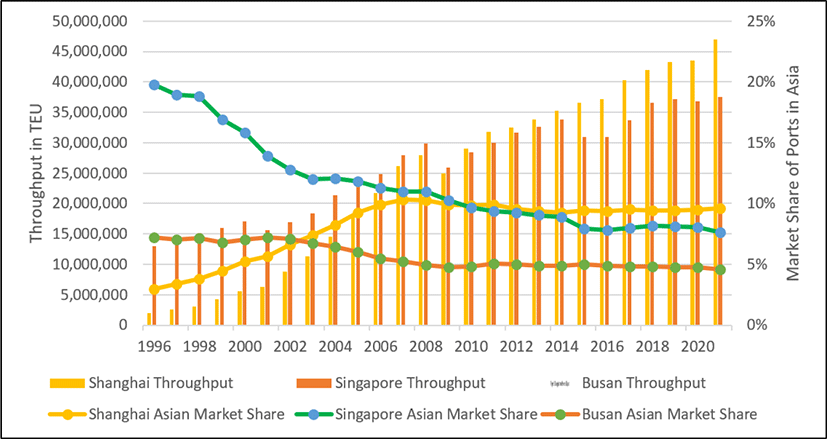
In the short term, geopolitical tensions such as the US-China trade war, pandemics, or any events and accidents can disrupt the connectivity with the adjacent ports and magnify its impact on Busan port. In the long term, the neighbouring Chinese ports can take Busan’s transhipment volume with their impressive growth rate. Even though these ports serve the large hinterland of China and are primarily used for exports and imports, their activities cannot be ignored by the neighbouring ports. Furthermore, China is currently the largest manufacturing hub globally, and Busan has strong liner connectivity with Chinese ports. However, as the economy of China is developing and the increasing labour cost can shift the production centres to other Asia countries like Vietnam, Thailand, Indonesia or even Africa. Busan needs to establish strategic partnerships with other countries and diversify its liner network. This will decrease the dependency of Busan port on other regional ports and improve container throughput resiliency for Busan under uncertainties.
Although Busan is the 7th largest port globally, it is still growing continuously with an average rate of about 6.4% over the last ten years. This nevertheless needs expansion to accommodate the growing demand. As there is a plan to establish four new container terminals in the New Busan port, adding about 8–10 million TEU capacity to the port, Busan needs to find additional volumes for this new capacity. As there is a shift in the manufacturing hub adding uncertainties to the global economy, additional volumes can only be achieved by attracting new trading partners/markets.
Despite several challenges for the Port of Busan, there are some interesting in unique opportunities for Busan port. The primary advantage of Busan port is its geographical location; that is, it is located at the junction of Asia (the manufacturing hub of the world because of the low labour cost) and North America (the consuming centre of the world because of the high GDP per capita) which is very similar to the strategic location of Singapore between Asia and Europe. All the liner services calling Asia / Far East to Europe have a call port to Singapore. Unlike Singapore, there are 30 liner services (out of 159 services) calling between Asia (either Singapore or Shanghai or both) and North America, which do not call Busan port. Busan port should develop strategic trade partners with shipping liners and countries to capture the trade between Asia and North America and increase the port’s throughput. These 30 liner services have a cumulative capacity of 160,122 TEUs weekly. Further, as explained in section 5.5, there are no major liner routes which are unique to the Port of Busan. All the major liner services calling Busan port also call Singapore and Shanghai. Busan should also strategically think about developing competitive strategies such as game-theory concepts, network design and port competition by having unique major liner routes (vis-à-vis Singapore and Shanghai) to increase the market share and develop competitive advantages (Anderson et al., 2008; Cullinane et al., 2004; Yap et al., 2006).
Regional and Intra Asia trade is a way forward to improve the transhipment volume for Busan. It could utilise the downgrading (transhipment volumes) trend of the neighbouring ports such as Hong Kong as a case study (Wang and Slack, 2000) to monitor and reform its policies. This could help to understand the needs of several feeder ports and provide an efficient solution to improve the transhipment network for Busan port.
7. Concluding Remarks
Currently, the international trade of commodities is facing turbulence and uncertainties due to the recent pandemic. The impose of port restrictions in China created an opportunity for the Port of Busan to attract more container ships for loading, discharging and transhipment in the region, resulting in an increase in container throughput for a few quarters in 2020. Macroeconomic uncertainties and risks can also increase the port market share for the players who have developed strategies and agility to encash the opportunities. This indicates that just being aware of the possibility is not sufficient; instead, ports should be well prepared for availing these opportunities.
In this respect, this study explores the intra-dependency ratio between Busan, Singapore, and Shanghai ports for containers using common and exclusive liner services from AIS data. It also provides a case study of several challenges and opportunities for the Port of Busan. Even though the maritime industry has been a predominant and well-established industry, there has been limited usage of big data and technological advancement in decision making compared to other industries such as finance, pharmaceutical and even aviation. The data related to the maritime industry, especially for ports, are not readily available. Hence, the decisions related to ports are not always scientific; instead, port managers, policymakers, and others use their experience and qualitative assessments for managerial and operations-related decisions and develop long-term strategies for ports. Combining management experience and evidence from quantitative data of shipping lines and port connectivity (container lines and trading route related data) can result in robust decision-making.
A major takeaway from this study is that exploring big data in maritime and ports can complement managerial decision making to (i) develop risk management strategies for ports and (ii) retain and increase the port market share. While there was no clear evidence of when and how ports could benefit from the usage of big data in maritime a decade ago, there has been a growing interest and practices to build a decision support system for global supply chain management (Jha et al., 2020) and so as for ports/infrastructure. This emphasises that the usage of big data in maritime is an emerging topic, where ports need to invest more in research to develop competitive advantage vis-à-vis other ports.








